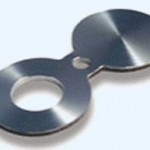How to Calculate for Flange Forces

A flange is a small plate or ring used to connect two sections of pipe together. As a flange may connect pipes that have very different physical properties (e.g. cross-sectional area of the pipes or speed of flow of fluid through them), there may be forces exerted on the flange of the pipe that must be taken into account, especially when determining how strong the flange must be to withstand these forces. Calculating flange forces can be done by considering the flow properties of the two sections of pipe held together by the flange.
1
Apply a thin coat of pipe joint compound to the outside threads of the bushing. More is not better. Too much pipe dope can create blockages inside your piping system.
2
Screw the bushing into the pipe flange counterclockwise until it is hand tight. Excess joint compound will be pushed out as the bushing is inserted into the flange.
3
Turn the adjustment nut on one pipe wrench so the wrench jaws fit the narrow side of the flange. The wrench jaws are loose until the teeth bite into the flange sides. Once the first wrench is correctly sized to the pipe flange, set the wrench aside.
4
Turn the adjustment nut on the second pipe wrench to fit the flat sides of the bushing, much like a wrench on a nut.
5
Set the first wrench, jaws up and away from you, on the floor. Use your heel to balance the wrench as you lock the flange, bushing side to your left, into the jaws.
6
Tighten the bushing into the flange by using the second wrench in a downward motion. With the flange wrench facing up, balanced by your foot and holding the flange securely, leverage the second wrench on the bushing by using your body weight to push down on the handle.










